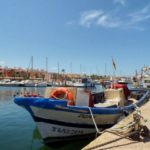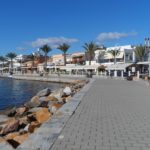Less than an hour south of Torrevieja lies the Cartagena town of Cabo de Palos, undoubtedly one of the most charming coastal towns in the Region, according to the specialised travel guide Lonely Planet, which also selects it as among the most beautiful on the Spanish coast.
There are many reasons to fall in love with this small town, that has one of the most impressive lighthouses in the country. Its coves, its seabed, its houses, its marine atmosphere, its restaurants… all make Cabo de Palos a tourist destination that many of us seek.
But nothing is perfect, not even this little town that looks out over the sea and where bougainvillea bushes peek out from the walls.
One of the most popular attractions is the Cabo de Palos Lighthouse, constructed in 1863, lighting up for the first time two years later. At that time, olive oil was used, which was stored in a well inside the tower, which was raised with a pulley. Its 54-metre height made it the tallest lighthouse in the Mediterranean and the second in Spain, 269 steps loaded with history and anecdotes leading to the top.
Unsurprisingly, the Lighthouse has witnessed many historical episodes such as the shipwreck of the Sirius, the Italian steam liner in which nearly three hundred passengers and which is remembered by a plaque on the base. They say that the captain and the officers reacted cowardly, being the first to get into the lifeboats; that the zarzuela singer Lola Millanes was traveling on board, whose body washed up in Torrevieja; and that the safe was found open and empty, but with no signs of having been forced. The fisherman Vicente Buigués is also remembered, for saving numerous passengers, being decorated for it on the only day, they say, in which he was ever seen wearing a suit.
In 1938 El Faro also witnessed the most important naval battle of the Civil War between Nationals and Republicans, which resulted in 700 deaths and around a hundred missing. Franco commissioned a film about the battle, El crucero Baleares, but the film did not pass the censor and all copies were ordered to be destroyed. This symbol of Cabo de Palos has also become the subject of the film The Last Lighthouse Keepers.
Although Cabo de Palos is a tourist destination with its population increasing exponentially in summer, it is still a town with a fishing tradition. A manifestation of this is its port, where the nets are set very early in the waters where the fishermen rest. That seafaring flavour is present throughout the town, its architecture and gastronomy, it’s famous fishmonger in the heart of the town where you can find all kinds of fresh fish.
Cabo de Palos also has a beach, the Paseo de Levante, but also numerous coves with crystalline waters (in one of them, as a curiosity, there is a duck-shaped rock formation). In addition, funds from the Cabo de Palos-Islas Hormigas Marine Reserve have made this area one of the favourites in Spain, and in Europe, for scuba diving. Even David Bisbal has been seen Cabo de Palos on more than one occasion diving with one of the many diving schools that are in the town. It is a type of tourism that lasts throughout the year, not only during the summer months.
Since the beginning of the 20th century, Cabo de Palos has been, in addition to being a charming fishing village, the exclusive holiday destination for wealthy families who chose this part of the coast to build large summer residences in which to gather the whole family during the hot summer months. From the Paseo de Levante to the cliffs, passing through La Zeneta or Calaflores, there are many magnificent houses that, among the bougainvillea, azalea and other flowering shrubs, leave the visitor speechless.
Have breakfast on the terrace of Paseo de la Barra, in front of the breakwater an ideal location to ‘people watch’, as you can watch the comings and goings of passers-by; or taste a caldero, the star dish of the Mar Menor, in the restaurants of Cabo de Palos, just some of the pleasures that the gastronomy of this Cartagena town offers. In fact, the small community concentrates a large number of establishments specialising in many different types of cuisine. They are the mythical El Mosqui (“from the sea the grouper and from El Mosqui the cauldron”), La Tana or the Miramar, to which we could add many others that have earned a reputation over the years.
“It’s not perfect, but it is closer to what I just dreamed of,” Pablo Milanés sang. And yes, Cabo de Palos, as much as we like it, does have some aspects to improve. To highlight just a few, the excess of brick; mobility problems (especially traffic in the summer months); the abandoned Telegraph Station, for which UPCT students devised different uses, the lack of pavements in some areas, or the plot that the El Katy restaurant has left at the entrance of the town after it was demolished.
But it still one of the many jewels and one that is certainly worth a visit. If you don’t already know Cabo de Palos, well, you’ve got some homework to do! It’s wonderful setting, marine atmosphere and beguiling coastal promenade are only a short trip away from the southern Costa Blanca, and what’s more, a wonderful meal awaits in the restaurants that line its peaceful seafront.









